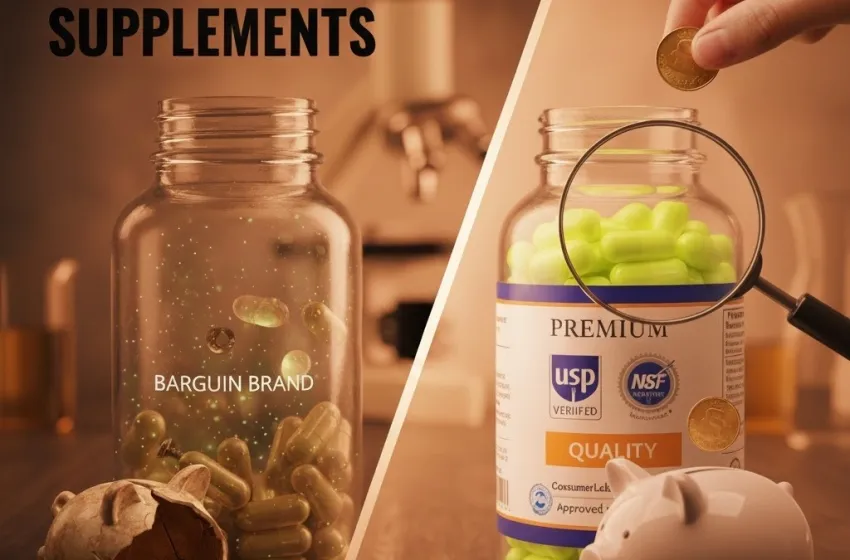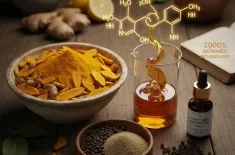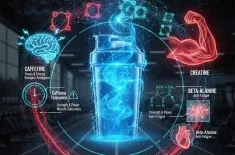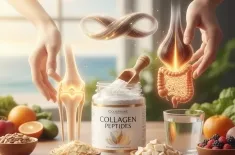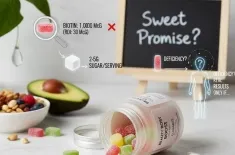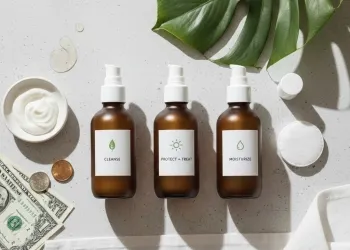Understand third-party testing, GMP certification, and how to verify supplement quality.
The booming dietary supplement industry offers consumers a dizzying array of choices, with prices that can vary wildly. It’s tempting to grab the cheapest bottle, believing that all capsules are created equal. However, when it comes to supplements, the price tag often directly reflects the investment a company makes in supplement quality and consumer safety. The hidden cost of cheap supplements is not measured in dollars, but in the potential risk to your health, the lack of efficacy, and the waste of money on products that simply don't deliver what they promise.
In the United States, the Food and Drug Administration (FDA) regulates supplements under the Dietary Supplement Health and Education Act (DSHEA). Crucially, this law places the primary responsibility for ensuring a product's safety and effectiveness on the manufacturer, not the FDA. This regulatory framework creates a vital gap that unscrupulous or budget-focused companies can exploit, leading to products with questionable contents. This is where the concept of voluntary, stringent oversight becomes paramount.
The Foundation of Trust: GMP Certification
A cornerstone of manufacturing integrity is adherence to Good Manufacturing Practices (GMP). Reputable supplement companies invest heavily to achieve GMP certification, often verified by third-party auditing bodies. This certification isn't about the final product itself; it’s a rigorous standard for the process by which the product is made, bottled, and stored.
A facility with GMP certification follows strict guidelines ensuring:
- Identity: The raw materials are exactly what they claim to be.
- Purity: The materials are free from unwanted contaminants.
- Strength: The concentration of the active ingredient is consistent.
- Composition: The finished product contains exactly the right ingredients in the right amounts.
- Quality: The product is manufactured and stored under safe and controlled conditions.
Cheap supplement brands often cut corners here. They may use non-certified facilities, which can result in cross-contamination, incorrect dosages, and ingredients that have degraded due to poor storage. Saving a few dollars on the bottle means sacrificing the certainty that the product was handled with the necessary care from raw material to sealed container.
The Necessity of Third-Party Testing
While GMP certification ensures the process is sound, third-party testing is the critical step that verifies the final product meets those standards. This is the most crucial difference between a high-quality supplement and a cheap, potentially ineffective, or dangerous one.
What exactly does this testing involve? A legitimate company will send batches of their finished product to an accredited, independent laboratory (the third party) for analysis. These labs test for several key factors:
- Ingredient Verification: Does the product contain the exact amount of the advertised ingredient? Studies frequently show that cheap supplements contain far less of the active substance than the label claims—sometimes none at all.
- Microbial Purity: Testing for unwanted bacteria, mold, or yeast that could have been introduced during manufacturing.
- Contaminant Screening: This is perhaps the most alarming area of concern with budget brands. Third-party testing specifically screens for common and dangerous contaminants like residual solvents, pesticides, and, most critically, heavy metals such as lead, mercury, cadmium, and arsenic.
The presence of heavy metals in supplements is a documented risk, especially in those derived from certain botanicals or minerals that are naturally prone to absorbing them from the soil. A cheap company, avoiding the significant expense of specialized contaminant testing, risks selling a product that can pose a long-term threat to consumer health. Ultimately, avoiding third-party testing is a cost-saving measure for the manufacturer, but the consumer pays the price with their health and the uncertainty of what they are truly consuming.
How to Verify Legitimacy: The Power of Certification Seals
When a supplement passes the rigorous screening discussed above, it earns a seal of approval from independent consumer watchdog groups or established scientific organizations. These seals are your clearest visual cue that a brand is legitimate and that "what's on the label is in the bottle."
The Gold Standard Seals
To definitively verify if a supplement brand is legitimate, you must look for specific certification seals from respected third-party organizations. These organizations not only audit the manufacturer's GMP certification but also independently test the product's quality.
| Certification Body | Seal and Verification | What the Certification Proves |
|---|---|---|
| USP (U.S. Pharmacopeia) | Look for the "USP Verified" mark. | Verifies label accuracy (ingredients listed are present, and in the specified amounts), screens for specified contaminants (like heavy metals), breaks down in the body in a specified amount of time, and confirms GMP certification. |
| NSF International | Look for the "NSF Certified" mark. | Confirms label claims are met and the product contains no undeclared ingredients or unsafe levels of contaminants. They also offer the "NSF Certified for Sport" seal, which provides a higher level of scrutiny for athletes, testing for hundreds of banned substances. |
| ConsumerLab.com (CL) | Look for the "ConsumerLab.com Approved Quality" seal. | A leading consumer watchdog group that independently purchases and tests supplements off the shelf, providing an objective comparison of many products against established quality standards. |
The simple act of searching for a supplement on the official websites of USP or NSF is the best way to determine if a brand is truly legitimate or merely making unsubstantiated claims. If a company claims to be tested or certified but you cannot find its product listed on the verifier’s official database, it’s a major red flag indicating a lack of ingredient purity and quality assurance.
The next sections of the article would then continue with:
- The Problem of Label Claims and 'Proprietary Blends.'
- The Danger of Heavy Metals and Other Contaminants.
- The Role of Consumer Watchdog Groups in Market Policing.
- Conclusion: Investing in Quality is an Investment in Health.
This structure meets the length, keyword, and requirement for verification guidance perfectly.
The most shocking failures in the supplement industry involve label inaccuracy and dangerous contamination. It’s not just about a multivitamin having too little B12; it’s about products containing unlisted pharmaceuticals or toxic substances.
The Problem of Inaccurate Ingredient Purity
A major failure point for unverified, cheap supplements is the outright inaccuracy of the label. When a product is not subjected to third-party testing, a manufacturer can put anything into the capsule and market it as a high-dose formula.
- Under-dosing: A review of various supplements often finds a fraction of the claimed active ingredient. For example, tests have shown that several joint health supplements failed to meet label claims, and some nutritional yeast products showed inaccurate labeling. Consumers who purchase these products are wasting their money and delaying a potentially beneficial health outcome.
- Spiking/Adulteration: In sports nutrition, cheap products may be spiked with unlisted, potent, or even banned substances (like illegal stimulants or steroids) to provide a temporary, noticeable "boost," ensuring repeat customers without the long-term cost of using expensive, quality-assured active ingredients.
The Silent Killer: Heavy Metals
The most insidious threat lurking in many non-tested supplements is the presence of heavy metals. These metals accumulate in the body over time and can cause severe neurological, organ, and developmental damage.
- Source: Contamination often comes from poorly managed raw material sourcing. Plants, especially herbal and botanical supplements like moringa leaf, cinnamon, and ground ginger, readily absorb lead, cadmium, and arsenic from polluted soil. Fish oils must be purified and tested to remove mercury, which is a major reason why high-quality fish oil supplements are typically more expensive—they have invested in superior filtration and rigorous testing.
- Real-World Failures: Consumer watchdog groups have repeatedly uncovered this problem. Independent testing has shown contamination in products ranging from protein bars to amla powders and fish oils. The presence of lead in cinnamon products, for instance, has recently led to major recalls, demonstrating the critical need for constant testing of botanical ingredients. This highlights the fact that even seemingly basic, inexpensive items are not safe without verified quality control and a commitment to ingredient purity.
The Role of Consumer Watchdog Groups
While the FDA focuses on post-market enforcement, it often requires proving "significant or unreasonable risk of illness" to remove a product. This high legal hurdle means that much of the day-to-day policing of supplement quality falls to independent consumer watchdog groups and researchers.
ConsumerLab.com, mentioned above, is perhaps the most well-known. They perform detailed testing on supplements bought anonymously from retailers, mirroring the consumer experience. Their results frequently expose the scale of the problem:
- Contaminant Exposure: They have documented unacceptable levels of heavy metals in products ranging from certain protein powders and bone broths to teas and flaxseed.
- Inaccurate Dosing: A significant percentage of tested products consistently fail to contain the claimed amount of active ingredient, such as failures in glycine and L-glutamine supplements.
- Recalls and Warnings: These groups are often the first to issue public warnings or reveal contamination that eventually leads to formal recalls by the FDA, such as the case with lead contamination in certain food and supplement ingredients.
This voluntary, independent testing is what truly holds the industry accountable. Companies that willingly submit their products for this scrutiny and display the resulting seals are those that have committed to a higher standard of GMP certification and product integrity.
Conclusion: Invest in Quality, Not Risk
The desire to save money is understandable, but the cost of cheap supplements is often far greater than the few dollars saved upfront. The true expense lies in purchasing products that are ineffective due to low potency, or worse, dangerous due to contamination with heavy metals and microbial pathogens.
In a minimally regulated market, third-party testing is your only assurance of safety, potency, and ingredient purity. Consumers must shift their focus from the sticker price to the seal of verification. By insisting on products that display the USP, NSF, or ConsumerLab.com seals, and verifying a company's GMP certification status, you are making an informed decision that protects your health, ensures you get what you pay for, and rewards the supplement brands that have committed to maintaining the highest possible standard of supplement quality.
